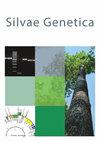Variation and Evolution of Genome Size in Gymnosperms
IF 1
4区 农林科学
Q3 FORESTRY
引用次数: 2
Abstract
Abstract Gymnosperms show a significantly higher mean (1C=18.16, 1Cx=16.80) and a narrow range (16.89-fold) of genome sizes as compared with angiosperms. Among the 12 families the largest ranges of 1C values is shown by Ephedraceae (4.73-fold) and Cupressaceae (4.45-fold) which are partly due to polyploidy as 1Cx values vary 2.41 and 1.37-fold respectively. In rest of the families which have only diploid taxa the range of 1C values is from 1.18-fold (Cycadaeae) to 4.36-fold (Podocarpaceae). The question is how gymnosperms acquired such big genome sizes despite the rarity of recent instances of polyploidy. A general survey of different families and genera shows that gymnosperms have experienced both increase and decrease in their genome size during evolution. Various genomic components which have accounted for these large genomes have been discussed. The major contributors are the transposable elements particularly LTR-retrotransposons comprising of Ty3gypsy, Ty1copia and gymny superfamilies which are most widespread. The genomes of gymnosperms have been acquiring diverse LTR-RTs in their long evolution in the absence of any efficient mechanism of their elimination. The epigenetic machinery which silences these large tracts of repeat sequences into the stretches of heterochromatin and the adaptive value of these silenced repeat sequences need further investigation.裸子植物基因组大小的变异和进化
裸子植物与被子植物相比,其基因组大小的平均值(1C=18.16, 1Cx=16.80)显著高于裸子植物,而基因组大小的差异(16.89倍)较小。在12个科中,1C值范围最大的是麻科(4.73倍)和柏科(4.45倍),部分原因是多倍体,其1Cx值分别为2.41和1.37倍。在其他只有二倍体分类群的科中,1C值的范围从1.18倍(苏铁科)到4.36倍(podocarpace科)。问题是裸子植物是如何获得如此大的基因组大小的,尽管最近多倍体的例子很少见。对裸子植物不同科属的调查表明,裸子植物的基因组大小在进化过程中既有增加又有减少。已经讨论了构成这些大基因组的各种基因组成分。主要贡献者是转座子,特别是由Ty3gypsy、Ty1copia和gymny超家族组成的ltr -反转录转座子,它们分布最广。裸子植物的基因组在其长期的进化过程中获得了多种LTR-RTs,但缺乏有效的消除机制。这些大范围重复序列沉默进入异染色质延伸的表观遗传机制以及这些沉默重复序列的适应价值需要进一步研究。
本文章由计算机程序翻译,如有差异,请以英文原文为准。
求助全文
约1分钟内获得全文
求助全文
来源期刊

Silvae Genetica
农林科学-林学
CiteScore
2.20
自引率
10.00%
发文量
10
审稿时长
3 months
期刊介绍:
Silvae Genetica is an international peer reviewed journal with more than 65 year tradition and experience in all fields of theoretical and applied Forest Genetics and Tree breeding. It continues "Zeitschrift für Forstgenetik und Forstpflanzenzüchtung" (Journal of Forest Genetics and Forest Tree Breeding) founded by W. LANGNER in 1951.
 求助内容:
求助内容: 应助结果提醒方式:
应助结果提醒方式:


